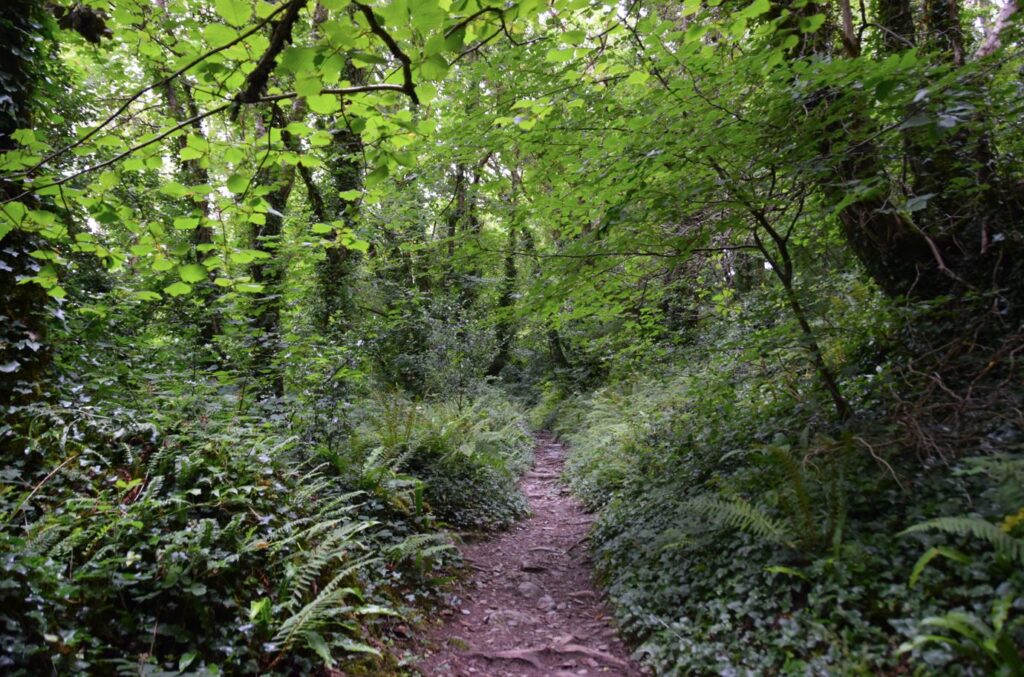| Distance: 10 km / 6 miles |
| Start / End: Pont Quay |
| Toilets: Lantivet National Trust car park, Polruan Hill car park, |
| Lunch: Picnic on a bench above Lantic Bay |
| Hidden gem: Lantic Bay |

“There is no bad weather, only inappropriate equipment”. The weather forecast says it’s going to rain. We’ve put all our waterproof gear on and set off.








Pont Quay is in a river valley. We have to climb first before descending to Lantic bay. The footpath near Pont Quay is quiet. It’s under a thick tree canopy, and ferns grow lushly under these dark and humid conditions. We step on a thick brown carpet of foliage from the previous autumn.
Shortly, we entered the graveyard of St Wyllow’s Church. Most of the current church are from the 14th century. The church was restored in 1906. Many medieval relics remain. Particularly eye-catching are the Royal Coat of Arms, presented in 1865 (in gratitude for the parish’s loyalty to the Crown during the Civil War), crests of prominent local families on wooden panels and lavish wood carvings at the ends of the pews. It is said that no other church in Cornwall retains so much medieval woodwork.
Daphne du Maurier, the author of Rebecca, was married here in 1932 and used the church as the model for the church of Lanoc in her first novel, The Spirit of Love.
We pass through the churchyard and turn left to go downhill along the country lane. The lane is narrow and soon walled by high hedges. Worried about traffic, especially since summer is the hay harvest season, we almost trot along the road, fearing that if a tractor appears, we may end up like the dormouse in the field. Luckily the high hedge section is not long, and not a single car comes.
Passing the National Trust car park, after a bit more road walking, we arrive at a tree tunnel. Through it, we are transported into a watercolour painting consisting of an azure ocean, couple of white sailing boats and endless green rolling hills, topped with breeze, wildflowers and butterflies. The coastal trail goes up and down like ocean waves.
After a strenuous ascent, we peer down to the secluded Lantic Bay. The water is as translucent as the Mediterranean Sea. It looks like a tropical beach without palm trees.
Looking at the flight of stairs leading to the beach and the further altitude I must conquer; I suppress the temptation to cool down my feet in the turquoise water. While I rest, a fleet of people wearing flip-flops, carrying beach towels and picnic baskets pass us. I guess they came straight from the car park and there wasn’t any warning about the steep descent to the beach.
I speed up the rest of the hike, as I’m desperate for a Loo. Polruan seems further than I thought. I cherish the sight of the first house. There is a public toilet in the car park. I survey the whole car park and eventually find it at the road entrance. With a relieved bladder, I now have the mood to explore Polruan, which is a village dwarfed by C.Toms and Son boatyard. The insistent piercing sound of steel grinding can be heard throughout Fowey Estuary from Monday to Saturday. There is a pub at the quay, called Lugger, with window frames painted blue and external pipes painted red and a tea shop at the crossing, above the quay, full of locals, but not appealing for the tourists. Next to it, a crowd gathers; I suspect that’s the bus stop, though there’s no sign of a bus timetable. The streets of Polruan are a far cry from the touristy Fowey.
The rain starts to drop at the exact hour the forecast predicted. We search for the Hall Walk as that’s our route back. With the Polruan quay in the rain and the screeching boat-cutting sound behind, we are happy to discover the Hall Walk is in the woods with tree canopies sheltering us from the downpour. A few gaps in the woods reveal the view of the riverbed under a low tide. Tomorrow evening, we shall see the river at the highest tide of this month.


Leave a Reply